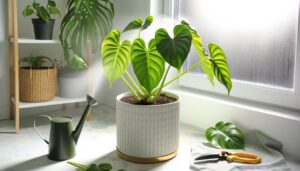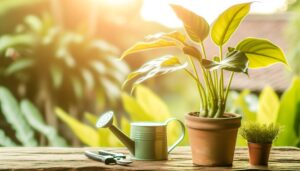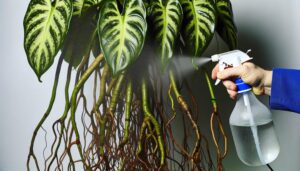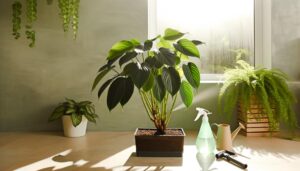How Do You Care for Philodendron Verrucosum? Tips and Tricks
Philodendron Verrucosum, hailing from rainforests of Central and South America, requires attentive care to thrive. Ensure a high-moisture environment available with tepid watering when the top soil inch is dry.
It prefers an indirect, diffused light, ideally from a north/east-facing window. A well-draining, nutrient-rich, peat-based soil mix provides prime growth conditions.
Fortify with balanced, slow-release fertilizer monthly during the growing season. Vigilance in disease prevention is key with a focus on root rot and leaf spot disease.
Further exploration will offer more in-depth knowledge on each aspect of Verrucosum care.

Key Takeaways
- Provide Philodendron Verrucosum with diffused, indirect light, using curtains or blinds to filter direct sunlight.
- Water the plant when the top inch of soil is dry, using tepid water and maintaining high humidity through misting or a humidifier.
- Use a well-draining, nutrient-rich soil mix, preferably peat-based, and include perlite for enhanced drainage.
- Fertilize monthly during the growing season with a slow-release balanced fertilizer to promote healthy growth.
- Prevent diseases like root rot and leaf spot by avoiding overwatering, ensuring good soil drainage, and regularly inspecting for early signs of disease.
Understanding Philodendron Verrucosum’s Natural Habitat
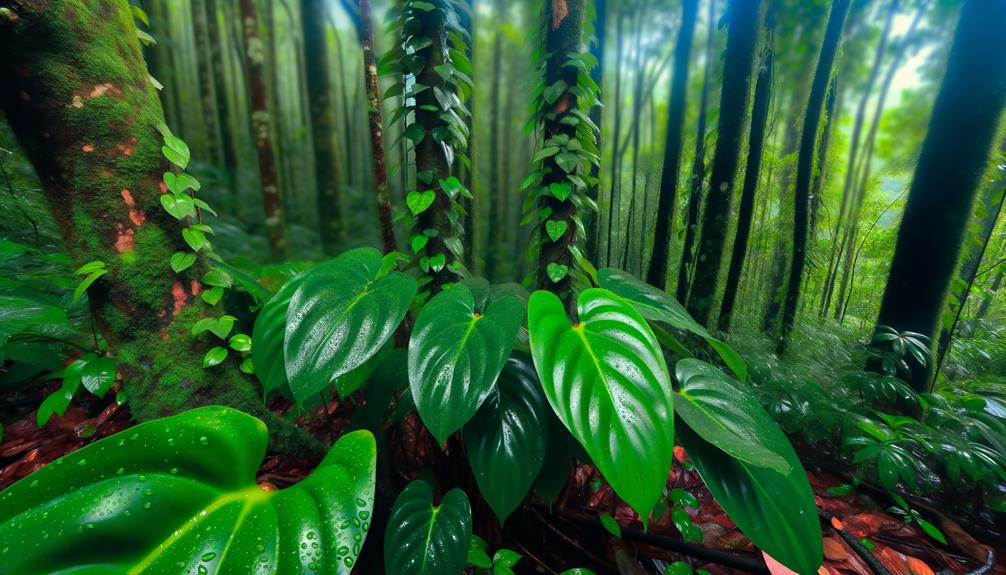
To appropriately care for Philodendron Verrucosum, it is essential to explore its natural habitat, primarily found in the rainforests of Central and South America, where the plant has adapted to specific environmental conditions over centuries. These environments are characterized by high humidity, consistent temperatures, and rich, well-draining soil.
The Verrucosum’s aerial roots, which latch onto trees for support, are an adaptation to this rainforest ecosystem. The plant also possesses a velvety texture and deep ridges on its leaves, likely a mechanism to maximize surface area for photosynthesis while minimizing water loss.
Understanding these adaptations can help us recreate conditions conducive to the plant’s growth in an indoor setting, thereby aiding its survival and flourishing.
Optimal Lighting for Verrucosum Growth
Drawing on insights derived from its natural habitat, the Philodendron Verrucosum requires a specific range of light intensity for best growth, with a preference for diffused, indirect lighting conditions. These conditions closely mimic the plant’s original rainforest environment, where sunlight is often filtered through a dense canopy.
To achieve optimal lighting for Verrucosum growth, consider the following:
- Place your plant near a north or east-facing window for softer light.
- Avoid direct sunlight as it can cause leaf burn.
- Use curtains or blinds to filter the light if necessary.
- Monitor the plant’s response to light changes, adjusting as necessary.
Through these guidelines, one can create an environment conducive to Verrucosum growth, thereby serving both the plant’s needs and your desire for a flourishing indoor garden.
Correct Watering Techniques
Just as the appropriate illumination conditions are essential for the growth of Philodendron Verrucosum, proper watering techniques also play a significant role in maintaining its overall health and robustness.
Ensuring the right water quantity and frequency is key: too much water may lead to root rot, while too little can cause the plant to wilt. As a general rule, water your Verrucosum when the top inch of soil feels dry to the touch. It’s also beneficial to use tepid, rather than cold water to avoid shocking the plant’s system.
Additionally, this species appreciates high humidity. Hence, regular misting or usage of a humidifier can help mimic its natural rainforest habitat, enhancing its growth and vitality without oversaturating the soil.
Soil and Fertilizer Recommendations
Plunging into the domain of soil and fertilizers, it’s crucial to understand that Philodendron Verrucosum thrives best in well-draining, nutrient-rich substrates, which is why the selection of appropriate soil and fertilizers becomes a pivotal aspect of its care regimen.
- Peat-based mix: This type of soil provides the necessary drainage and aeration for the roots. Regular potting soil can compact over time, which impedes root growth.
- Perlite: Adding perlite to the soil mix increases drainage, preventing water-logging.
- Slow-release fertilizers: These provide a steady supply of nutrients over an extended period. Use a balanced fertilizer with equal parts nitrogen, phosphorus, and potassium.
- Monthly application: Apply fertilizer during the growing season, typically from spring to early autumn. Avoid over-fertilizing as it can lead to fertilizer burn.
Preventing Common Verrucosum Diseases
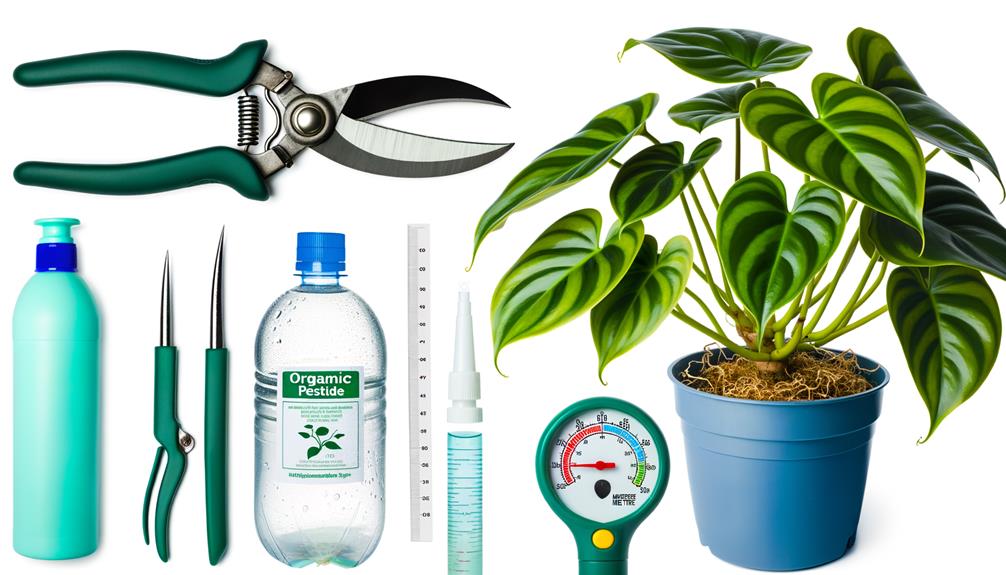
Exploring the realm of plant diseases, highlighting that Philodendron Verrucosum is prone to several common ailments, emphasizing that prevention of these issues requires diligent care and keen observation.
Root rot, a prevalent disease, is often the consequence of overwatering or inadequate drainage, leading to the decay of the roots. Observational vigilance is crucial, as initial symptoms include yellowing leaves and drooping growth.
Another ailment, leaf spot, manifests as dark, water-soaked spots on leaves, frequently triggered by bacterial or fungal pathogens. To ward off these diseases, ensure the plant is in a well-draining potting mix, avoid overwatering, maintain ideal humidity, and regularly inspect your plant for early signs of disease.
It is through these preventive measures that we can promote the health and longevity of our Philodendron Verrucosum.
Conclusion
To sum up, Philodendron Verrucosum‘s survival and growth are closely linked to the replication of its natural habitat. Ideal lighting, watering methods, appropriate soil composition, and consistent fertilization greatly contribute to its flourishing existence.
Moreover, a deep understanding of potential diseases and their prevention can guarantee the longevity and health of this exquisite plant. This combination of factors creates a favorable environment for the Philodendron Verrucosum, a tribute to the beauty of botanical science.

